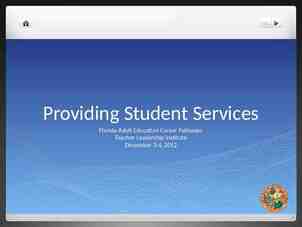CS 5412/LECTURE 24 FAULT TOLERANCE IN PRACTICE Ken Birman Fall, 2022
53 Slides5.15 MB

CS 5412/LECTURE 24 FAULT TOLERANCE IN PRACTICE Ken Birman Fall, 2022 HTTP://WWW.CS.CORNELL.EDU/COURSES/CS5412/2022FA 1

HOW DO APACHE SERVICES HANDLE FAILURE? We’ve heard about some of the main “tools” Zookeeper, to manage configuration HDFS file system, to hold files and unstructured data HBASE to manage “structured” data Hadoop to run massively parallel computing tasks Hive and Pig to do NoSQL database tasks over HBASE, and then to create a nicely formatted (set of) output files HTTP://WWW.CS.CORNELL.EDU/COURSES/CS5412/2022FA 2

BASIC STEPS Detecting the failure Reporting the failure to the elements of the application software Synchronizing so that each layer is fully self-repaired before any other layer manages to “see” it or tries to update it HTTP://WWW.CS.CORNELL.EDU/COURSES/CS5412/2022FA 3

HOW TO DETECT A FAILURE It isn’t as easy as you might expect HTTP://WWW.CS.CORNELL.EDU/COURSES/CS5412/2022FA 4

REMINDER: FAILURES AND “TRANSIENTS” LOOK THE SAME A network or scheduling delay can mimic a crash FLP was built around the idea of always needing to be certain. If a process was healthy, FLP insists that its vote must be considered. In “real” systems like Apache, we don’t want the to wait while one machine deals with a broken link. We need to move on! HTTP://WWW.CS.CORNELL.EDU/COURSES/CS5412/2022FA 5

? WAYS TO DETECT FAILURES Something segment faults or throws an exception, then exits A process freezes up (like waiting on a lock) and never resumes A machine crashes and reboots HTTP://WWW.CS.CORNELL.EDU/COURSES/CS5412/2022FA 6

SOME REALLY WEIRD “FAILURE” CASES When clocks “resynchronize” they can jump ahead or backwards by many seconds or even several minutes. What would that do to timeouts? Could TCP connections “instantly” break? Clocks can also freeze up and not move at all during resynchronization. HTTP://WWW.CS.CORNELL.EDU/COURSES/CS5412/2022FA 7

SOME REALLY WEIRD “FAILURE” CASES Suppose we just trust TCP timeouts, but have 2 connections to a process. What if one connection breaks but the other doesn’t? can you think of a way to easily cause this? This actually can happen! FTP uses two connections, one for control and one for data movement It will crash if either of them goes down HTTP://WWW.CS.CORNELL.EDU/COURSES/CS5412/2022FA 8

USEFUL PERSPECTIVE FROM STUDIES Why Do Computers Stop and What Can Be Done About It? Written around 1980 by Jim Gray. He blamed operator errors and software bugs. Hardware crashes were rare! This triggered a lot of work on software engineering for reliability in complex distributed systems HTTP://WWW.CS.CORNELL.EDU/COURSES/CS5412/2022FA 9

BOHRBUGS AND HEISENBUGS Bruce Lindsay Bohrbug is a solid mistake. Easy to reproduce and hence to fix Cloud of protons, neutrons surrounded by cloud of electrons Heisenberg’s Atomic model Heisenbug is often a sideeffect of some error earlier in the execution. Shifts due to concurrency. Hard to pin it down and fix it. HTTP://WWW.CS.CORNELL.EDU/COURSES/CS5412/2022FA 10

SAVED BY SOFTWARE ENGINEERING! The “clean room” development and testing process helps a lot Design patterns for correct concurrent programming also make a huge difference, such as the “monitor” coordination model in Java and C With these methods, software (and even hardware) bug rates have dramatically improved HTTP://WWW.CS.CORNELL.EDU/COURSES/CS5412/2022FA 11

MORE INSIGHT FROM JIM GRAY’S STUDY He also found that operators often make errors. Leads to a lot of modern attention on automated self-configuration and cleaner GUIs And he found that the people who patch software often introduce new bugs! Leads to a modern focus on regression testing to make sure patches don’t create issues, or just “shift” issues. HTTP://WWW.CS.CORNELL.EDU/COURSES/CS5412/2022FA 12

MORE RECENT PAPER Study of datacenter failures by Yahoo: BFT for the Skeptics. 2009 SOSP, Flavio Junqueira, Yee Jiun Song, Benjamin Reed The authors discovered that Byzantine faults basically never occur in datacenters. Similarly, FLP-style problems never occur But they often saw network outages that caused transient partitioning HTTP://WWW.CS.CORNELL.EDU/COURSES/CS5412/2022FA 13

BOTTOM LINE? Software bugs used to cause most crashes, but are less and less of an issue. For better reliability, don’t route your internet through a goat pen Improvement due to a “cleanroom” coding style, unit testing, release testing, quality assurance team, acceptance testing, integration testing. Hardware reliability is better too. Operator error and physical events such as roof leaks remain common causes of major outages HTTP://WWW.CS.CORNELL.EDU/COURSES/CS5412/2022FA 14

KEEP-ALIVE MESSAGES The idea here is to have healthy systems do something actively to report “still ok”. They could even run an internal self-check first, periodically. We call these “keep-alives”, meaning “I am still alive, keep me in your list of healthy members. Each server could send a keep-alive to every other server, or to just a few neighbors. When we talked about gossip, we saw this in Kelips. HTTP://WWW.CS.CORNELL.EDU/COURSES/CS5412/2022FA 15

WHAT IF A TIMEOUT GOES OFF “INCORRECTLY?” Recall James Hamilton’s 3 R’s Reboot, then Reimage, then Replace Most data centers today offer a way that one machine can toggle the power switch for some other machine! This guarantees a reboot HTTP://WWW.CS.CORNELL.EDU/COURSES/CS5412/2022FA 16

DUELING REBOOTS Obviously, we could have a shoot-out But this won’t happen often James Hamilton would say that if something like this occurs, there is probably a root cause like a broken network connection, and very likely we actually should exclude those machines in any case! HTTP://WWW.CS.CORNELL.EDU/COURSES/CS5412/2022FA 17

BROADER PHILOSOPHY: THE CLOUD MUST STAY ON Never let the fate of one or two machines somehow control the cloud! A cloud system is replicated and elastic and large We should always keep the majority up and running, even if this trims away a bunch of machines because they seem to be broken. Their “opinion” that they are healthy is not relevant! HTTP://WWW.CS.CORNELL.EDU/COURSES/CS5412/2022FA 18

AS A TIME-LINE Healthy system doing work Failure occurs and is detected New work will have to Healthy wait! again! Healthy system resumes normal work Any system needs to go through a series of stages to deal with failues If the failure could have damaged data or left an execution in a disrupted state, cleaning up will be important. HTTP://WWW.CS.CORNELL.EDU/COURSES/CS5412/2022FA 19

THREE KINDS OF ISSUES TO THINK ABOUT How does each element work when things are healthy? How does each element detect failures, and if needed, repair itself to recover from damage the fault might have caused (such as a file that wasn’t fully written, and should be deleted and regenerated)? How do the layers synchronize? If layer A lives on layer B, when layer A is ready to restart after a crash, can it be sure that B is already repaired? HTTP://WWW.CS.CORNELL.EDU/COURSES/CS5412/2022FA 20

ZOOKEEPER ROLE One ring to rule them all HTTP://WWW.CS.CORNELL.EDU/COURSES/CS5412/2022FA 21

ZOOKEEPER “REMINDER” Zookeeper is an implementation of a virtual-synchrony service (they don’t use these words, but they do use this model!) to track system state and configuration data. The basic idea is that your application processes connect to Zookeeper via TCP. It monitors their health. And it reports membership via a small file. HTTP://WWW.CS.CORNELL.EDU/COURSES/CS5412/2022FA 22

ZOOKEEPER FILES Limited size (currently 1MB). Version replacement feature eliminates the need for costly locking. Notification when a file you are watching is updated. Zookeeper itself has a file holding membership data (process IP addresses). Detects failures if a TCP connection breaks, auto-updates. Applications can also create files. They store configuration data in them. Files are held in memory. HTTP://WWW.CS.CORNELL.EDU/COURSES/CS5412/2022FA 23

GUARANTEES? Zookeeper is a lot like any virtual synchrony system The service itself is replicated over 3-5 nodes for availability It will never suffer split-brain problems State machine replication for the files it manages. In effect, a POSIX file system but just used for configuration data HTTP://WWW.CS.CORNELL.EDU/COURSES/CS5412/2022FA 24

TWO FORMS OF MEMBERSHIP! Zookeeper tracks its own membership in this example, the five servers When the Zookeeper service itself is not reconfiguring from failure, Zookeeper is tracking the status of clients ( members of the application) Client joins? Zookeeper uses atomic multicast to update the list of active client processes and to track any metadata the client supplies Client fails? Zookeeper learns this (as we discussed) and then notifies all healthy clients that the membership file has been updated HTTP://WWW.CS.CORNELL.EDU/COURSES/CS5412/2022FA 25

CLIENTS WILL SEE THESE UPDATES They reread the file and adjust their internal data structures For example, any client with a TCP connection to a failed client closes that connection. During this transitioning period, some clients might have switched to the new membership and others could be lagging. Developers must plan for this and tolerate this period of asynchronous switchover! HTTP://WWW.CS.CORNELL.EDU/COURSES/CS5412/2022FA 26

ATOMIC MULTICAST: WEAKER THAN PAXOS! Paxos also has a durability guarantee and it applies to every update. Zookeeper doesn’t have true durability. It does periodic checkpoints once every K seconds, where K must be 5s. For their protocols, making each update durable immediately is slow Derecho doesn’t have this issue, but our protocol is more efficient. HTTP://WWW.CS.CORNELL.EDU/COURSES/CS5412/2022FA 27

KEY INSIGHT Atomic multicast protocols are designed to: 1. Send copies of messages to all participants but they won’t yet be delivered to anyone. Called pending messages 2. Wait until every healthy receiver has a copy a) b) This status might be detected by a leader: the 2-phase commit pattern Or it might be independently/directly sensed by members: Derecho SST approach 3. Only at when all have a copy do deliveries occur. HTTP://WWW.CS.CORNELL.EDU/COURSES/CS5412/2022FA 28

CONTRAST WITH PAXOS Paxos does durable log updates, but has also been proposed as the basis of multicast protocols. In Paxos, pending messages arise in phase 1 Recall that in this phase leader(s) contend to get their proposed message into a quorum QW of slots using a series of ballots Phase 2 commits the successful message, but at this point it is already certain to be in QW logs, saved to disk. HTTP://WWW.CS.CORNELL.EDU/COURSES/CS5412/2022FA 29

FAILURE DISRUPTS A MULTICAST? Virtually synchronous systems like Zookeeper and Derecho “self-repair, then advance” with no real rollback (no delivered message is ever withdrawn) Pattern seen in these: Freeze everything. Leader collects current status from healthy members For each pending multicast, decide if it should be delivered or not. Leader commits this outcome via 2-phase protocol involving healthy members. Pending multicasts that were not delivered are resent in the next epoch (view) HTTP://WWW.CS.CORNELL.EDU/COURSES/CS5412/2022FA 30

FAILURE DISRUPTS A MULTICAST? In Cascade, layered over Derecho, the effect is that failures are “erased” and completely hidden from higher-level application logic. But more complex outcomes can still arise because the failure may also have disrupted applications running on other nodes. Apache examples illustrate this and how it is resolved. HTTP://WWW.CS.CORNELL.EDU/COURSES/CS5412/2022FA 31

WHAT IF A FAILURE DISRUPTS PAXOS? This can become extremely complex! Not a topic for CS 5412 But there are quite a few cases one must consider. In the worse case, Paxos can “commit” to leave a log entry empty – it commits in that slot Requires a case-by-case analysis and proofs. Paxos was so hard to reason about that it led Lamport to create the TLA theorem prover! At Cornell, we favor Coq/VST, Dafny/Z3 or Ivy/Z3 for this kind of protocol verification. HTTP://WWW.CS.CORNELL.EDU/COURSES/CS5412/2022FA 32

LAYERED RECOVERY Unfortunately, this is very complex HTTP://WWW.CS.CORNELL.EDU/COURSES/CS5412/2022FA 33

THE PUZZLE Suppose that Zookeeper notifies HDFS, HBASE, Hadoop and Apache SQL that some nodes have failed. They might all need to self-repair. But HBASE can’t self-repair until HDFS has finished! And Hadoop can’t restart jobs until HBASE is self-repaired, etc. In effect, we need a layer-by-layer recovery HTTP://WWW.CS.CORNELL.EDU/COURSES/CS5412/2022FA 34

THE APACHE SELF-REPAIR LOGIC IS TRICKY A good explanation of HDFS self-repair can be found here. It is many pages long, and very detailed, requires a lot of internal knowledge about how HDFS is implemented. We won’t do a deep dive . Layer by layer synchronization isn’t standardized in Apache. The HDFS version involves “refreshing” something called a “block lease” and is integrated with the HDFS replication logic HTTP://WWW.CS.CORNELL.EDU/COURSES/CS5412/2022FA 35

IT CENTERS ON A CONCEPT CALLED A “LEASE” The term means “time-bounded lock” HDFS has an internal design in which data actually is stored into replicated blocks. While doing a write, the application must have a block write lease. To read the block, the application must have a read lease. HDFS uses leases as its main tool to buy time for selfrepair when a crash disrupts it. HTTP://WWW.CS.CORNELL.EDU/COURSES/CS5412/2022FA 36

HOW WOULD HDFS SELFREPAIR? HBASE? HDFS learns that a failure has occurred when Zookeeper updates the map of system components and roles. HDFS then invalids active leases while it repairs any damaged blocks. Now, think about HBASE. All HBASE state is stored in HDFS, so if HBASE is running and HDFS has a crash, HBASE must refresh its block leases. This refresh waits until HDFS self-repair completes. HBASE itself is stateless (HBASE state lives in HDFS files), so at this point HBASE has been self-repaired too. HTTP://WWW.CS.CORNELL.EDU/COURSES/CS5412/2022FA 37

WHAT ABOUT HADOOP? Hadoop itself is stateless too, like HBASE. So in some sense the same policy works for Hadoop. But now we have layers of higher level applications! Each needs services from layers below it. This stack “terminates” in HDFS leases. In more complex systems, we might have more than one stateful service. That makes recovery trickier! HTTP://WWW.CS.CORNELL.EDU/COURSES/CS5412/2022FA 38

EXAMPLE OF A COMPLEX RECOVERY Hadoop job disrupted by a crash when HDFS itself was also disrupted by the crash HTTP://WWW.CS.CORNELL.EDU/COURSES/CS5412/2022FA 39

REMEMINDER: HDFS CHECKPOINTS HDFS adds a “checkpoint” feature to what POSIX normally can support. The checkpoint is just a file that contains the names, version numbers and lengths of the files your Hadoop application is using. To “roll back” it just truncates files back to the size they had and restores any deleted files. This doesn’t work for files you deleted or replaced. So Hadoop jobs need to delay deleting or replacing files until HTTP://WWW.CS.CORNELL.EDU/COURSES/CS5412/2022FA 40

VISUALIZING HADOOP FAILURES IN IMAGES jo b Mapped tasks: A B C.ou t A.ou B’ t B.ou tB.ou t C D D.ou E.ou t t E Normal case: A, B E just run, create output (key,value collections in HDFS files), then the reduce step can run. Failure case (B crashes). Now Hadoop just rolls back any files B was appending to and runs B’, to repeat the HTTP://WWW.CS.CORNELL.EDU/COURSES/CS5412/2022FA 41

OTHER ASPECTS OF ROLLBACK Hadoop also has to worry about jobs that might be running exactly when the failure occurred. Very often such a job could be disrupted in some way, hence active tasks shouldn’t be allowed to continue running “as is”. Hadoop kills all the user-generated tasks, removes any files they may have created and restores any then deleted, then reruns the failed tasks. HTTP://WWW.CS.CORNELL.EDU/COURSES/CS5412/2022FA 42

THIS CONCEPT WORKS IN ALL OF APACHE The whole Apache infrastructure centers on mapping all forms of failure handling to Zookeeper, HDFS files with this form of “rollback”, and task restart! It has similar effect to an abort/restart in a database system, but doesn’t involve contention for locks and transactions, so Jim Gray’s observations wouldn’t apply. Apache tools scale well (except for Zookeeper itself, but it is fast enough for the ways it gets used). HTTP://WWW.CS.CORNELL.EDU/COURSES/CS5412/2022FA 43

AIR TRAFFIC CONTROL FAULT TOLERANCE A non-Apache example HTTP://WWW.CS.CORNELL.EDU/COURSES/CS5412/2022FA 44

WHAT ABOUT AIR TRAFFIC CONTROL? These systems have a system-wide virtual synchrony view manager. The role of the view manager is to atomically report to all components when any failure disrupts any component. When a view changes, all components instantly “wedge” and adjust to the new view The system briefly (seconds not minutes) freezes up and repairs itself, and when it resumes, every component is HTTP://WWW.CS.CORNELL.EDU/COURSES/CS5412/2022FA 45

WHAT ABOUT AIR TRAFFIC CONTROL? These systems have a system-wide virtual synchrony view manager. The role of the view manager is to atomically report to all components when any failure disrupts any component. When a view changes, all components instantly “wedge” and adjust to the new view Rollback is not an option! HTTP://WWW.CS.CORNELL.EDU/COURSES/CS5412/2022FA 46

WHAT ABOUT AIR TRAFFIC CONTROL? These systems have a system-wide virtual synchrony view manager. The role of the view manager is to atomically report to all components when any failure disrupts any component. When a view changes, all components instantly “wedge” and adjust to the new view The system briefly (seconds not minutes) freezes up and repairs itself, and when it resumes, every component is HTTP://WWW.CS.CORNELL.EDU/COURSES/CS5412/2022FA 47

FAILURE IN AN ATC SYSTEM A modern air traffic control system might have a structure like this: Flight plan manager tracks current and past flight plan versions Message bus . Air traffic controllers update flight plans WAN link to other ATC centers Flight plan update broadcast service Microservices for various tasks, such as checking future plane separations, scheduling landing times, predicting weather issues, offering services to the airlines HTTP://WWW.CS.CORNELL.EDU/COURSES/CS5412/2022FA 48

COMPARE WITH APACHE? Air traffic control might have state in a few places, but it helps that the flight plan records reside in a single database that every other process simply mirrors, readonly. The key thing is to ensure that we never have parts of the system using one set of flight plans, or one set of configuration files, while the remainder is using a different set. And this property is very carefully verified. HTTP://WWW.CS.CORNELL.EDU/COURSES/CS5412/2022FA 49

CONNECTION WITH DERECHO/CASCADE The ATC architecture we are looking at was literally built using the Isis Toolkit, an older version of Derecho So Derecho can be viewed as using this exact same approach! Failure sensing via timeouts or “application detected issues” Spread-the-word: Uses a gossip approach, “shun” the failed process Freeze and self-repair, then restart and reissue any requests that got wiped out by the rollback HTTP://WWW.CS.CORNELL.EDU/COURSES/CS5412/2022FA 50

WRAPUP Sense failures, force reboots if needed. Do a clean rollback, resume from checkpoint HTTP://WWW.CS.CORNELL.EDU/COURSES/CS5412/2022FA 51

BOTTOM LINE? The cloud is highly available, because it has layers of backups – even backup datacenters and backups at geographic scale. IoT data managed by the cloud can be strongly consistent. This doesn’t really reduce availability and in fact doesn’t even reduce performance. It leads to a style of coding in which membership is managed for you. But many parts of the existing cloud are using weaker consistency today, and you need to be aware of the risks when you use those tools. HTTP://WWW.CS.CORNELL.EDU/COURSES/CS5412/2022FA 52

EFFECTS OF BOTTOM LINE? Today’s cloud is remarkably robust. We use CAP and weaken consistency in outer layers, but this is partly because doing so actually simplifies the solutions we create. Fault tolerance is easy when you don’t worry about consistency. Systems that do need consistency use the “timeline”: they have a standard way to detect failure. Every component learns of any fault relevant to it. Disrupted components pause their work queues while they self-repair. HTTP://WWW.CS.CORNELL.EDU/COURSES/CS5412/2022FA 53






